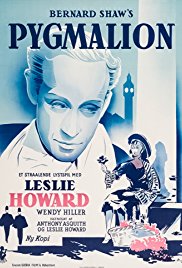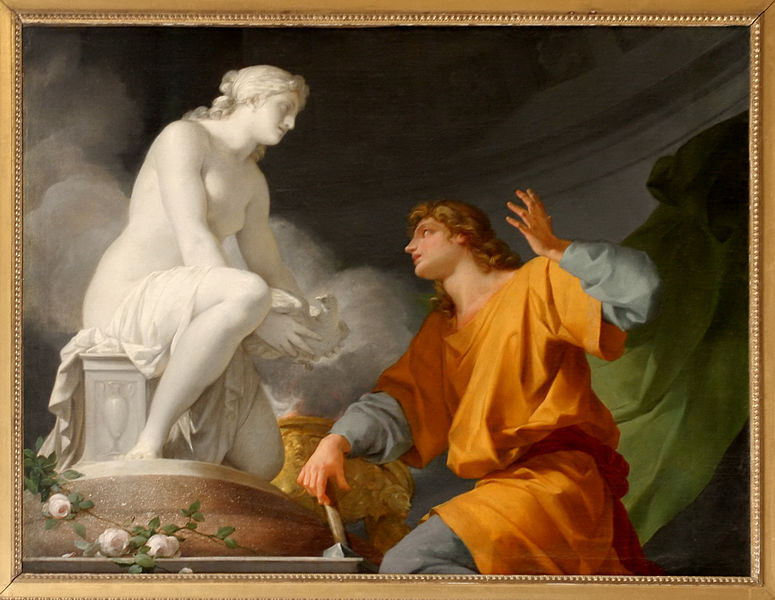PYGMALION
SUBJECTS — Drama/England; World/England;
SOCIAL-EMOTIONAL LEARNING — Breaking Out; Romantic Relationships;
MORAL-ETHICAL EMPHASIS — Caring.
AGE: 12+; No MPAA Rating;
Comedy; 1938; 96 minutes; B & W. Available from Amazon.com.
There is NO AI content on this website. All content on TeachWithMovies.org has been written by human beings.

SUBJECTS — Drama/England; World/England;
SOCIAL-EMOTIONAL LEARNING — Breaking Out; Romantic Relationships;
MORAL-ETHICAL EMPHASIS — Caring.
AGE: 12+; No MPAA Rating;
Comedy; 1938; 96 minutes; B & W. Available from Amazon.com.
TWM offers the following worksheets to keep students’ minds on the movie and direct them to the lessons that can be learned from the film.
Film Study Worksheet for ELA Classes and
Worksheet for Cinematic and Theatrical Elements and Their Effects.
Teachers can modify the worksheets to fit the needs of each class. See also TWM’s Movies as Literature Homework Project.
Professor Henry Higgins boasts to a friend that he can teach a flower girl with a thick Cockney accent to “speak like a lady.” She overhears him. A few days later, she appears at his door offering to pay for speech lessons. “Pygmalion” is a popular play written by George Bernard Shaw. The screenplay for the movie was also written by Shaw. The play served as the basis for the musical My Fair Lady.
Selected Awards:
1938 Academy Awards: Best Adapted Screenplay; 1938 Venice Film Festival Awards: Best Actor (Howard); 1938 Academy Award Nominations: Best Picture, Best Actor (Howard), Best Actress (Hiller).
Featured Actors:
Leslie Howard, Wendy Hiller, Wilfred Lawson, Marie Lohr.
Director:
Leslie Howard and Anthony Asquith.
“Pygmalion” describes how an accent can determine social status and economic opportunity. It also provides an introduction to phonetics and to the Greek myth of Pygmalion. The movie allows children to work through the romantic situations of Eliza, Higgins and Eliza’s friend, Freddie. Eliza demonstrates an inner strength that will not accept the limitations of a class system that denies the intrinsic value of the individual. Higgins, immersed in his studies, is blind to most human emotions. This black and white version is appropriate for older children who are studying drama, who love My Fair Lady, or who are studying Greek.
MINOR. Alcohol use and smoking are shown. The ending in which Eliza returns to Higgins despite his insistence on treating her like a servant is problematic and may disappoint, if not infuriate, children who have been raised at a time when gender equality is assumed. George Bernard Shaw also had a problem with this ending and wrote a sequel to the play in which Eliza rejects Higgins and marries Freddie.
After watching the movie tell your child the Greek myth of Pygmalion. See the Helpful Background section. Then talk about the issues raised by the film, including the importance of language in determining social status and how poorly Professor Higgins treats Eliza. Ask and help your child to answer the Quick Discussion Question. If your child is outraged that Eliza would go back to Higgins, see the Possible Problems section above.

See Learning Guide to My Fair Lady.
George Bernard Shaw (1856-1950) was an internationally acclaimed Irish playwright and a devout socialist. After bouncing from one failed career to another, he found his life’s work as a playwright. Shaw made his American debut with “Man and Superman,” which was an immediate hit. Between 1895 and 1939 he wrote 49 successful plays each of which contained a message of social significance. He only allowed two of his plays to become movies, “Pygmalion” and “Major Barbara.” George Bernard Shaw won the Noble prize for literature in 1925. His other major works include “Caesar and Cleopatra” (1906), “Androcles and the Lion” (1912), “Back to Methuselah” (1921), and “St. Joan” (1923).
In Greek mythology, Pygmalion was a sculptor who made a beautiful marble statue of a woman. He named it Galatea. The statue was so beautiful that he fell in love with it. He doted on the statue, perfected it, dressed it, gave it jewelry and talked to it. Aphrodite, the Goddess of Love, took notice of Pygmalion. She granted Galatea life and instructed her to love Pygmalion. Galatea and Pygmalion were married and lived happily to the end of Pygmalion’s days. Shaw adapted this myth to Victorian England.
1. See Discussion Questions for Use With any Film that is a Work of Fiction.
2. In what way do people in the U.S. classify others by the way they speak? Is “broadcast” English the mark of an educated person?
3. How have radio and television influenced the way in which we speak? What effect do radio and television have on regional accents?
4. Why did Professor Higgins decide to teach Eliza to speak like a “Lady?” Was this fair to Eliza?
5. Who do you think learned more from the experiment, Professor Higgins or Eliza? What do you think each of them learned?
6. Compare the storyline in this movie with the story of My Fair Lady. What are the differences?
1. What do you think about the way in which Henry Higgins treated Eliza?
2. At the end of the movie, should Eliza have gone back to Higgins and, if so, under what conditions?
3. What was the basis of the attraction between Eliza and Henry Higgins? Should Eliza have instead gone off with Freddie? After all, he adored her and wouldn’t treat her like a servant.
Discussion Questions Relating to Ethical Issues will facilitate the use of this film to teach ethical principles and critical viewing. Additional questions are set out below.
(Be kind; Be compassionate and show you care; Express gratitude; Forgive others; Help people in need)
The text of the play is excellent reading, especially after having seen the film or stage production.
This Learning Guide was last updated on December 17, 2009.